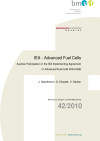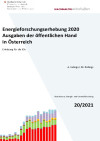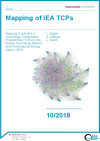Suchergebnisse
IEA-IETS Annex 15: Industrial Excess Heat Recover (Phase 2)
In the framework of IEA IETS Annex 15 potentials of excess heat and technologies for their integration were collected from national research projects, bundled and elaborated on. This way, a broad knowledge base was built on experience gained in carrying out surveys for potential use of excess heat. Experiences with questionnaires, process integration tools and extrapolation of data using existing knowledge about the respective energy systems were exchanged. A process database with detailed process information could also be established, which can be used for further research activities. Also, in the area of policy instruments, recommendations for future measures to increase the use of surplus heat were derived on the basis of national contributions.
IEA DHC Annex TS9: Digitalisation of District Heating and Cooling – Improving Efficiency and Performance Through Data Integration (Working period 2024 - 2028)
To successfully digitalize district heating and cooling (DHC), it is important to understand the benefits of incorporating digital processes into DHC networks. The purpose of this project is to investigate solutions for data transfer and processing between the components of DHC networks, with a focus on interoperability and standardization. Furthermore, non-technical hurdles and enablers to digitization processes in the DHC sector are assessed.
IEA AMF Task EATS: Exhaust gas aftertreatment systems (working period 2024 - 2027)
Internal combustion engines with renewable fuels are indispensable for the decarbonization of the hard-to-electrify industrial and transport sectors. The AMF TCP EATS Task is investigating effective exhaust aftertreatment technologies to achieve air quality comparable to electrified applications. Emissions are being analysed, suitable measurement methods identified and guidelines for limiting emissions developed.
IEA - Advanced Fuel Cells

Austrian Participation in the IEA Implementing Agreement on Advanced Fuel Cells 2004-2008
Schriftenreihe
42/2010
J. Gesellmann, G. Simader, V. Hacker
Herausgeber: BMVIT
Englisch, 89 Seiten
Downloads zur Publikation
IEA IETS Annex 17: Membrane filtration for energy-efficient separation of lignocellulosic biomass components
The overarching goal of IEA IETS TCP Annex 17 is to strengthen the network of the Austrian membrane and biorefinery landscape.
IEA CERT-EGRD Discussion: Evaluating the impacts of energy innovation policies
29. October 2021, 13:00 - 16:00
Online
The event brings together practitioners from governments with distinguished international scholars to exchange experiences and recommendations about how to design and implement evaluations clean energy innovation policies effecitiveness, from R&D funding programmes to broader support for the energy innovation ecosystem, as well as how to use these findings to improve policy design.
15th IEA Heat Pump Conference: Decarbonisation through Innovation
26. - 29. May 2026
Vienna
The leading scientific conference and meeting place for academia, industry, market, policy makers and investors interested in the field of heat pumping technologies. Under the motto ‘Decarbonisation through Innovation’, experts from all over the world will meet to present and discuss the latest advances and developments.
Visualisation of IEA TCPs 2020
International activities for the energy supply of the future are taking place within the framework of IEA's technology cooperation. Visualisations based on a graph database show the extensive activities of the individual technology cooperation programmes (TCPs). The collaborations of countries on individual topics were made clearly visible, too.
IEA Experts Group "R&D Priority Setting and Evaluation" (EGRD) - Working period 2017 - 2019
The IEA Experts Group (EGRD) was established by the Committee on Energy Research and Technology (CERT). It examines analytical approaches to energy technologies, policies, and research and development and evaluates the benefits of RTI policies. Its results and recommendations feed into IEA analysis, and enable a broad perspective of energy technology issues.
NAMA Guidelines for Land-Use and Bioenergy (2010)

The land use and bioenergy sectors from an integrated system. This system has features that are likely to require approaches distinct from those suitable for other sectors. Thus, although a general framework for NAMAs has been developed, requirements appropriate to specific sectors are needed.
Mehrsprachig
Energy Technology Perspectives 2015

Mobilising Innovation to Accelerate Climate Action
Herausgeber: International Energy Agency (IEA), ©OECD/IEA 2015 Energy Technology Perspectives, IEA Publishing
Englisch, 412 Seiten
Downloads zur Publikation
Putting Carbon back into the ground

Die Publikation "Putting Carbon back into the ground" des IEA Greenhouse Gas R&D Programme vom Februar 2001 zeigt die Möglichkeiten der Einspeicherung von CO2 und behandelt Fragen wie Umweltauswirkungen, Speichersicherheit und Kosten.
International Energy Agency
Englisch, 32 Seiten
Downloads zur Publikation
IEA Experts Group "R&D Priority Setting and Evaluation" (EGRD). Working period 2020 - 2022
The IEA Experts Group (EGRD) was established by the Committee on Energy Research and Technology (CERT). It examines analytical approaches to energy technologies, policies, and research and development and evaluates the benefits of RTI policies. Its results and recommendations feed into IEA analysis, and enable a broad perspective of energy technology issues.
Energy R&D 2019: Public Expenditures in Austria

The public energy research expenditures in 2019 amounted to 149,1 Mio Euro. In first place is energy efficiency (especially e-mobility, industry and buildings) followed by renewables (especially bioenergy and photovoltaics) as well as smart grids and storage.
10/2020
A. Indinger, M. Katzenschlager
Herausgeber: BMK
Deutsch, 134 Seiten
Downloads zur Publikation
EGRD Webinar: Energy Infrastructure - Public Acceptance
24. November 2020, 14:00 - 15:30 (CET)
Online
The transition to a sustainable, clean energy system requires restructuring with radical changes in how we produce, transmit and consume energy. This will only succeed with public engagement. The Webinar adresses questions like: What influences public perceptions of and responses to new energy technologies? How does the provision of information influence people's attitudes towards different technologies?
IEA C3E TCP: Kick-Off Call with the Austrian Ambassadors (2020)

On the morning of Friday, 26th of June 2020, a kick-off call was organized with the Austrian representatives of the C3E Initiative as well as the newly appointed Austrian Ambassadors for the period of 2020 – 2022.
Herausgeber: IEA C3E TCP
Englisch
Downloads zur Publikation
Energy R&D 2020: Public Expenditures in Austria

In 2020, about 1,000 projects and activities for publicly funded energy-related research, development and first-of-a-kind demonstration amounted to 155.2 million euros. As in previous years, the area of "energy-efficient end-use technologies" is in first place with expenditures of 76.8 million euros. The areas "smart grids and storage", "renewable energy" and "cross-cutting issues" follow by a comparatively wide margin.
20/2021
A. Indinger, M. Rollings
Herausgeber: BMK
Deutsch, 134 Seiten
Downloads zur Publikation
Webinar: EBC Technical Day - Energy innovations for the city of tomorrow
June 24th 2020
Online
The Webinar highlighted activities of the IEA TCP ”Energy in Buildings and Communities” (EBC) as well as results from Austrian R&D projects funded within the Austrian research and technology programme “City of Tomorrow”.
Mapping of IEA TCPs

The publication visualizes the current activities of the IEA Energy Technology Network and identifies possible gaps and overlaps. The mapping includes 185 ongoing tasks and annexes (Status September 2017).
Schriftenreihe
10/2018
Lukas Eggler, Andreas Indinger, Lukas Zwieb
Herausgeber: BMVIT
Englisch, 64 Seiten
